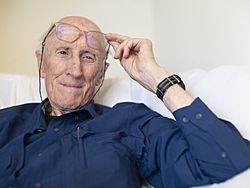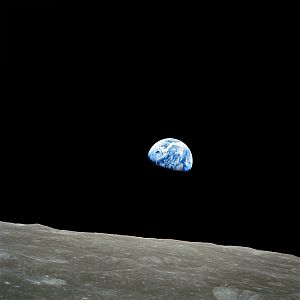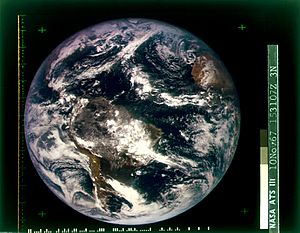Stewart Brand facts for kids
Quick facts for kids
Stewart Brand
|
|
|---|---|

Brand in 2020
|
|
| Born | December 14, 1938 Rockford, Illinois, United States
|
| Alma mater | Stanford University |
| Occupation |
|
| Known for | Whole Earth Catalog The WELL Long Now Foundation |
| Spouse(s) | Lois Jennings (1966–1973) Ryan Phelan (1983–present) |
Stewart Brand (born December 14, 1938) is an American writer and creator of many interesting projects. He is most famous for starting the Whole Earth Catalog, a popular magazine in the 1960s and 70s.
Brand also helped create The WELL, one of the first online communities. He also started the Global Business Network and the Long Now Foundation. He has written several books, including Whole Earth Discipline: An Ecopragmatist Manifesto.
Contents
Early Life and Education
Stewart Brand was born in Rockford, Illinois. For high school, he went to Phillips Exeter Academy in New Hampshire. He then studied biology at Stanford University and graduated in 1960.
After college, Brand joined the U.S. Army. He was a parachutist and taught skills to other soldiers. He later said that his time in the military helped him learn how to organize projects.
In 1962, he returned to California. He studied design and photography. During this time, he also took part in a scientific study of certain substances in Menlo Park, California.
In 1966, Brand married Lois Jennings, a mathematician. They divorced in 1973. He later married Ryan Phelan in 1983. They live on a 64-foot-long tugboat named Mirene, which was built in 1912. The boat is docked in Sausalito, California.
Creative Projects and Ideas
The Trips Festival
In the mid-1960s, Brand became involved with artists and writers in California. He helped organize the 1966 Trips Festival with author Ken Kesey. This was a famous event that mixed rock music with colorful light shows. It was one of the first big performances for the band the Grateful Dead. The festival was a key moment in the start of the "counterculture" movement in San Francisco.
Seeing the Whole Earth

In 1966, Brand had a powerful idea. He believed that if people could see a photograph of the entire Earth from space, it would change how they thought about the planet. At the time, NASA had not released any such photos.
Brand started a campaign to convince NASA to release a picture of the whole Earth. He made and sold buttons that asked, "Why haven't we seen a photograph of the whole Earth yet?"
In 1967, a satellite finally took the picture he had been waiting for. Brand used this image on the cover of the very first Whole Earth Catalog. A year later, in 1968, an even more famous photo called Earthrise was taken by an astronaut on the Apollo 8 mission. This photo appeared on the cover of the next Catalog.
Brand later explained why the image was so important. He said it "gave the sense that Earth's an island, surrounded by a lot of inhospitable space."
Helping with Computer Technology
In 1968, Brand helped an engineer named Douglas Engelbart show off some amazing new computer technologies. This event was later called "The Mother of All Demos". It introduced ideas like hypertext (clicking links to jump between pages), email, and the computer mouse for the first time.
Brand believed that with the right tools and information, people could build a better, more sustainable world.
The Whole Earth Catalog
In 1968, Brand and his team created the first Whole Earth Catalog. Its subtitle was "access to tools." The catalog was a guide to all sorts of useful items. It listed books, maps, gardening tools, camping gear, and even early computers.
The catalog didn't just list items. It also had reviews from experts, written like friendly letters. It told people where they could find or buy these "tools." The Catalog became very popular with people in the "do it yourself" and back-to-the-land movements.
The 1972 edition sold 1.5 million copies and won a National Book Award. Years later, Apple co-founder Steve Jobs mentioned the catalog in a famous speech. He quoted its final message: "Stay hungry. Stay foolish."
Later Work and Evolving Ideas
Magazines and Government Work
In 1974, Brand started a magazine called CoEvolution Quarterly. It published articles on science, art, and new ideas for the future. In the late 1970s, he also worked as a special advisor to California Governor Jerry Brown.
In 1985, Brand co-founded The WELL, which was one of the first online communities. It allowed people from all over the world to connect and share ideas long before the modern internet was common.
The Global Business Network
In 1988, Brand co-founded the Global Business Network. This group helped large companies think about the future. They used a method called "scenario thinking," which involves imagining different possible futures to make better plans today.
New Ideas on the Environment
For a long time, Brand supported using only "soft technology," like solar and wind power. But in 2005, his ideas began to change. He wrote an article suggesting that environmentalists should reconsider their views on things like nuclear power and genetically modified organisms (GMOs).
He argued that these technologies could be powerful tools to help fight problems like global warming. He explained these ideas more in his 2009 book, Whole Earth Discipline. He now calls himself an "eco-pragmatist," meaning he wants to use practical solutions to help the environment.
The Long Now Foundation
Brand is the president of the Long Now Foundation. The foundation encourages people to think about the very distant future.
One of its most famous projects is the Clock of the Long Now. This is a huge mechanical clock being built inside a mountain in Texas. It is designed to run for 10,000 years with very little human help. The clock is meant to be a symbol that inspires people to think about the long-term future of humanity.
See also
 In Spanish: Stewart Brand para niños
In Spanish: Stewart Brand para niños
- Bright green environmentalism



